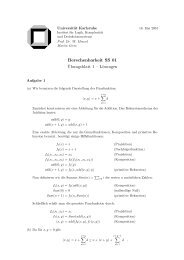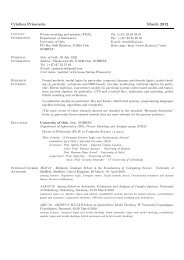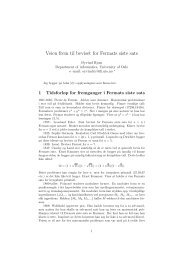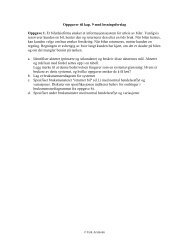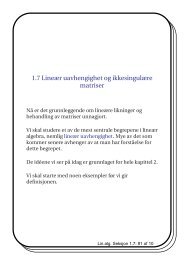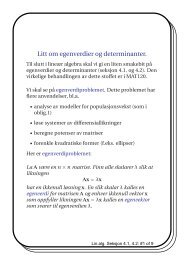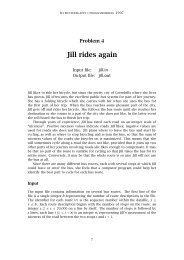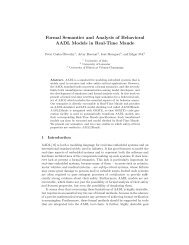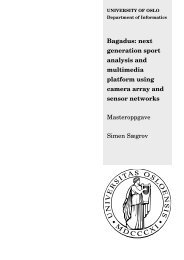Timed CTL Model Checking in Real-Time Maude⋆ - IfI
Timed CTL Model Checking in Real-Time Maude⋆ - IfI
Timed CTL Model Checking in Real-Time Maude⋆ - IfI
You also want an ePaper? Increase the reach of your titles
YUMPU automatically turns print PDFs into web optimized ePapers that Google loves.
<strong><strong>Time</strong>d</strong> <strong>CTL</strong> <strong>Model</strong> <strong>Check<strong>in</strong>g</strong> <strong>in</strong> <strong>Real</strong>-<strong>Time</strong> Maude 25<br />
that ¯r = GCD(R, t0, r, ϕ) is a def<strong>in</strong>ed non-zero time value. Then<br />
R, LΠ, t |=c ϕ ⇐⇒ R gcd(t0,r,ϕ) , LΠ, t |=p ϕ<br />
for all states t reachable <strong>in</strong> R gcd(t0,r,ϕ) from t0.<br />
Proof. Notice that t0 is also a state of R gcd(t0,r,ϕ) . Furthermore, all states t<br />
reachable <strong>in</strong> the abstraction R gcd(t0,r,ϕ) from t0 are also states reachable <strong>in</strong> R<br />
from t0.<br />
S<strong>in</strong>ce t is reachable <strong>in</strong> T K gcd , there is a path π pre ∈ tfPaths T K gcd(t0) lead<strong>in</strong>g<br />
from t0 to t. Let π pre be such a path and let n0 be the number of states <strong>in</strong> π pre .<br />
Note that π pre has tick steps of length ¯r/2 and also that π pre ∈ tfPaths T K(t0).<br />
We denote by T K the timed Kripke structure associated to R, by T K gcd the<br />
timed Kripke structure associated to R gcd(t0,r,ϕ) . By def<strong>in</strong>ition<br />
R, LP , t |=c ϕ ⇐⇒ T K, t |=c ϕ,<br />
R gcd(t0,r,ϕ) , LP , t |=p ϕ ⇐⇒ T K gcd , t |=p ϕ.<br />
Thus the theorem is equivalently proved, if we show that<br />
T K, t |=c ϕ ⇐⇒ T K gcd , t |=p ϕ.<br />
Given a T<strong>CTL</strong>cb formula of the k<strong>in</strong>d E ϕ1 UI ϕ2 or A ϕ1 UI ϕ2, we refer to<br />
the path formula ϕ1 UI ϕ2 as “the until path formula”.<br />
The proof is done by <strong>in</strong>duction on the structure of ϕ. Base cases:<br />
– ϕ = true: We have R, LP , t |=c true and R gcd(t0,r,ϕ) , LP , t |=p true for all t<br />
by def<strong>in</strong>ition of, respectively, |=c and |=p.<br />
– ϕ = p: We have R, LP , t |=c p iff p ∈ LP (t) iff R gcd(t0,r,ϕ) , LP , t |=p p, by<br />
def<strong>in</strong>ition of |=c and |=p.<br />
Assume now that the theorem holds by <strong>in</strong>duction hypothesis for ϕ1 and ϕ2 that<br />
is, respectively,<br />
R, LP , t |=c ϕ1 ⇐⇒ R gcd(t0,r,ϕ) , LP , t |=p ϕ1,<br />
R, LP , t |=c ϕ2 ⇐⇒ R gcd(t0,r,ϕ) , LP , t |=p ϕ2,<br />
for all states t reachable <strong>in</strong> the abstraction R gcd(t0,r,ϕ) from t0.<br />
– ϕ = ¬ϕ1:<br />
– ϕ = ϕ1 ∧ ϕ2:<br />
T K, t |=c ¬ϕ1 ⇐⇒ not (T K, t |=c ϕ1) (by def. of |=c)<br />
⇐⇒ not (T K gcd , t |=p ϕ1) (by <strong>in</strong>d. on ϕ1)<br />
⇐⇒ T K gcd , t |=p ¬ϕ1 . (by def. of |=p)<br />
T K, t |=c ϕ1 ∧ ϕ2 ⇐⇒ T K, t |=c ϕ1 and T K, t |=c ϕ2<br />
⇐⇒ T K<br />
(by def. of |=c)<br />
gcd , t |=p ϕ1 and<br />
T K gcd , t |=p ϕ2<br />
(by <strong>in</strong>d. on ϕ1 and ϕ2)<br />
⇐⇒ T K gcd , t |=p ϕ1 ∧ ϕ2 . (by def. of |=p)



